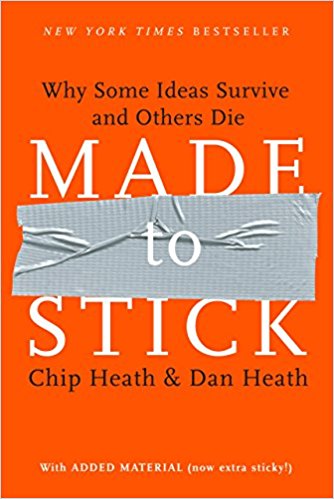Now Available: Organizational Readiness for Generative AI Draft White Paper

What-Why-How to Convey Meaning and Get Buy-In
A friend of mine asked for my input on a one-page marketing slick that he was planning on using to get organizations to sign up. As I looked at it, I was confused with what the organization was doing, why they were doing it (their mission), and ultimately what I’d need to do to engage. I realized that many marketing materials either don’t contain these critical components – or they aren’t crisp enough to be effective. That’s why I felt it was important to write this post – to make it easy for anyone to write good marketing copy for a web page, a one-pager, or a campaign.
What’s the Problem?
When you’re fishing, you’ve got to know what you’re fishing for. You need to know what fish you want to get on the hook. When you start with a marketing piece, you’ve got to know what the problem is that you’re trying to solve for your customer. What is their heartfelt pain that you can fix?
This isn’t the service that you provide – but it should be related. You don’t provide, for instance, water filters, you provide clean drinking water. People don’t want filters, they want what the filter can provide: clean drinking water. Providing clean drinking water to the world is a noble endeavor and one that people can get behind emotionally. However, bolstering this in explaining the what is telling a little mini-story with statistics and people.
Statistics
Statistics are easy enough to dismiss, but they can help us frame our perspective. If four out of five dentists recommend fluoride in your water, you know that most professionals seem to think it’s a good idea. Statistics that indicate why the problem is real validate the intuition of the person you’re speaking with. Statistics that expose the impact the problem is having on their world help them to understand the real pain that it’s creating in their world. It may be a dull, unidentifiable pain – until they can quantify what is going on and how much it is costing them.
People
People love a good story. They crave stories – we’re Wired for Story. However, too few marketing pieces are written like a good book, with a story to pull you in and get you to want to learn more. Sarah was just two when her mom and sister got sick and died. No one really knew why. Her dad came home and found them lying on the floor of their makeshift hut. A few hours later, he was digging a hole with a few members of the community to bury them. The grief was overpowering. She couldn’t tell whether her dad was sweating in the August sun or crying, and she dared not ask. There were no answers to why they died. Only the despair that follows such a loss. Years later, she was taken in by some well-meaning people and given a chance to attend school and learn. It was then that she realized that her daily trip to the lake to fetch water had probably brought home a parasite or bacteria that had taken her mother and sister from her.
No one wants to see Sarah suffer. A paragraph of mediocre writing was all it took for you to get wrapped into Sarah’s plight. Except Sarah isn’t real. It’s just a story. It’s a story that sets up the what – providing a world of suffering people a chance to have clean water – and for moms and sisters to survive.
It’s quicker, and easier, to find some testimonials for people who have been saved than to write stories – but it’s an essential part of your marketing message.
Why Are We Doing This?
Years ago, marketing was magic. You simply told the world you had a better mouse trap on the Mickey Mouse Club and the product rushed off the shelf. Back then, most consumers didn’t care whether your organization did good in the world or not. However, as our generations have changed, so has our need to explain our “why”. (See America’s Generations for more on generations.) Simon Sinek’s book Start with Why instructs us to look for our own “whys.” Though few people are willing to do this journey themselves, they want to feel good about themselves through buying products and services from organizations that they believe have a mission.
Most organizations have a mission. It may be poorly articulated and sitting in the bottom of a dusty drawer, but it exists. For most, it’s more than to make money – though, arguably, for some this is the only driver. Expressing the mission in a way that resonates with the target audience is important. Whether it’s fair trade, fair wages, or shoes for children, the mission matters.
The mission for you need not be a save-the-world, provide-clean-drinking-water, and save-lives sort of thing. In our technology business, we simply want to enable organizations’ success through technology. We want them to be successful with the help of technology. We don’t want them to be hampered in their success by something that should be easy.
How Are You Doing This?
We’ve got to believe. Not just to fly, like Peter Pan, but to do anything. If we don’t believe, then we don’t do. If we don’t believe there’s a chance that we’ll win – no matter how remote – we won’t play the lottery. It’s our belief that drives us. There are many ways that organizations try to build the belief in the mind of the prospect that they’re the right answer. For some, it’s branding exclusivity or indulgence. For others, it is rock solid stability. The organization seeks to convey the markers that create the belief in the mind of the prospect that the organization can give them what they want. However, there’s more to it than that. They need to believe that you know how you’re going to give them what they want. (See The Deep Water of Affinity Groups for more on how brands work.)
Sharing enough of how you’re going to solve the prospect’s problem helps them believe that you can solve it. How much you need to share to help them believe varies by what you’re doing and how different you are from your competition. Explaining that you’re going to end world hunger comes with a modicum of disbelief. Most people don’t believe that you can solve world hunger. To overcome this disbelief, you must have a believable how. If you want to provide clean drinking water to the world, you’ve got to share that you’ve got a water filter that works. You’ve got to share that it’s reliable, cheap, and works without electricity.
You don’t have to explain carbon filtering, chemical processes, or the resistance of the medium to water – you only must explain it in a way that makes it sufficiently plausible. Getting to 100% belief isn’t the goal of marketing – that’s sales. The goal of marketing is to develop a need in the prospects mind to reach out and take the next step.
Setting the Hook, the Easy Way
The final step is in creating a single and easy call to action. If you need someone to pick up the phone, then that’s your call to action. If your call to action is to visit your website, realize that you’ll have to get your website to have the clear call to action for the next step. While you generally can’t move a prospect immediately into a sale, your goal is to create a small number of very small steps to make it easy for the prospect to move through your sales funnel.
My ask for this post is simple. Subscribe or follow me on your favorite platform so we can continue the conversation. (You can also share this post too if you think your friends would find it valuable.) Subscribe via WordPress by clicking here (or you can get business-related updates by clicking here) and follow me on Twitter at Twitter.com/@RobBogue.



